
The Science of Clean Energy: Innovations That Are Changing the World
As the world grapples with the adverse effects of climate change and an ever-increasing demand for energy, the shift towards clean energy has become more critical than ever. Clean energy technologies aim to minimize environmental impact while meeting the energy requirements of growing populations. This article delves into the science of clean energy, exploring various innovative solutions currently reshaping the global energy landscape.
The Fundamentals of Clean Energy
Clean energy refers to power derived from renewable sources that have minimal negative impact on the environment. Key characteristics of clean energy include low or zero greenhouse gas emissions, sustainable practices, and an abundance that allows for long-term utilization. Some primary sources of clean energy include solar, wind, hydroelectricity, geothermal, and biomass.
Unlike fossil fuels, clean energy sources do not contribute to air pollution or the greenhouse gas effect, making them essential in the fight against global warming. The transition to clean energy involves advanced technologies, innovative methodologies, and bold policies aimed at reducing carbon footprints and achieving sustainability.
Solar Energy Innovations
Solar energy has been at the forefront of clean energy advancements, with significant innovations making it more accessible and efficient. Photovoltaic (PV) cells, which convert sunlight directly into electricity, have undergone remarkable improvements. The use of perovskite materials in solar cells has enhanced their efficiency rates, enabling higher energy conversion at a lower production cost.
Additionally, solar panel efficiency is further complemented by the emergence of bifacial solar panels, which capture sunlight on both sides, maximizing power generation. Hybrid solar systems, integrating solar technology with battery storage solutions, help to address the intermittency of solar power, thus ensuring a stable energy supply even during cloudy days or at night.
Wind Energy Breakthroughs
Wind energy has proven to be a powerful and cost-effective clean energy source, with ongoing innovations transforming the industry. The deployment of floating wind turbines allows for energy generation in deeper waters, where winds are generally stronger and more consistent. This advancement expands the potential for offshore wind farms, where the impact on land use and local ecosystems can be minimized.
Furthermore, advancements in turbine design, including larger rotor diameters and more efficient drivetrains, have significantly increased the capacity of wind turbines. Smart wind energy systems harness data analytics to optimize performance and predict energy output more accurately. These technologies pave the way for a more resilient and integrated energy grid.
Hydropower: Old Source, New Techniques
Hydropower has been utilized for centuries, but modern innovations are optimizing its efficiency and sustainability. Traditional dams can disrupt ecosystems, so innovative technologies such as run-of-the-river systems and hydrokinetic turbines, which extract energy from flowing water without extensive dam infrastructure, are gaining traction.
Moreover, small-scale hydroelectric systems are providing localized clean energy solutions, particularly in remote areas. The integration of hydropower with energy storage systems further enhances its role in stabilizing energy grids, especially when paired with other renewable sources.
Geothermal Energy Potential
Geothermal energy taps into the Earth’s internal heat, providing a reliable and consistent energy source. Recent innovations have led to enhanced geothermal systems (EGS), allowing for energy extraction in areas that were previously unsuitable for traditional geothermal plants.
New drilling technologies, such as enhanced drilling techniques and robotic systems, are reducing costs and improving the efficiency of geothermal resource access. Additionally, the development of closed-loop geothermal systems minimizes land disruption, further promoting its viability as a clean energy source.
Biomass Energy: The Circular Economy Approach
Biomass energy, produced from organic materials like agricultural waste, wood, and other biological matter, presents a sustainable alternative to fossil fuels. Recent innovations in biomass conversion technologies, such as advanced gasification and anaerobic digestion, are improving yield and efficiency.
The circular economy principles applied to biomass energy enhance sustainability by utilizing waste products, reducing landfill contributions, and providing a renewable fuel option. Furthermore, the integration of biomass energy with carbon capture technologies can potentially allow for negative carbon emissions, turning a suitable environmental solution into a vital carbon-reducing mechanism.
Energy Storage Solutions
One of the primary challenges of clean energy technologies is the variability of renewable energy sources. Energy storage solutions have emerged as critical components in overcoming these limitations. Advanced battery technologies, including solid-state batteries and flow batteries, are making energy storage safer, more efficient, and economically viable.
These storage systems enable the capture of surplus energy generated from renewable sources during peak production times, releasing it back into the grid when demand is high. Energy management systems that utilize artificial intelligence and machine learning are further optimizing energy usage and grid stability, allowing for better integration of clean energy into existing infrastructures.
Hydrogen: The Future Fuel
Hydrogen energy is garnering attention as a versatile cleaner alternative, especially for sectors that are hard to electrify, such as heavy industry and transportation. The generation of hydrogen through electrolysis, powered by renewable energy sources, produces green hydrogen—an emission-free fuel option.
Innovative fuel cell technologies transform hydrogen into usable electricity, while advancements in hydrogen storage and distribution systems enhance its practicality. Moreover, the exploration of hydrogen as an energy carrier in the context of a broader clean energy strategy demonstrates its potential role in achieving a low-carbon economy.
Policy and Future Directions
While technological advancements are driving clean energy innovations, supportive policies are equally integral to ensuring their successful adoption. Governments and organizations worldwide are incentivizing investments in renewable energy through subsidies, tax credits, and supportive regulations.
International agreements, such as the Paris Agreement, are setting ambitious targets for emissions reductions, actively pushing for the transition to cleaner energy sources. As countries formulate national energy strategies, collaboration between public and private sectors, research institutions, and communities will be crucial in shaping the future energy landscape.
Conclusion: A Sustainable Future Awaits
The ongoing innovations within the clean energy sector highlight humanity’s ability to adapt and overcome the challenges posed by climate change and resource scarcity. By embracing emerging technologies and sustainable practices, a transition towards a cleaner and more resilient energy future is not only possible but also imperative.
As public awareness of the environmental impact of energy consumption grows, so does the momentum for clean energy. As innovators worldwide continue to push the boundaries of possibility, clean energy can serve as the backbone of a sustainable global economy—fueling progress for generations to come.



